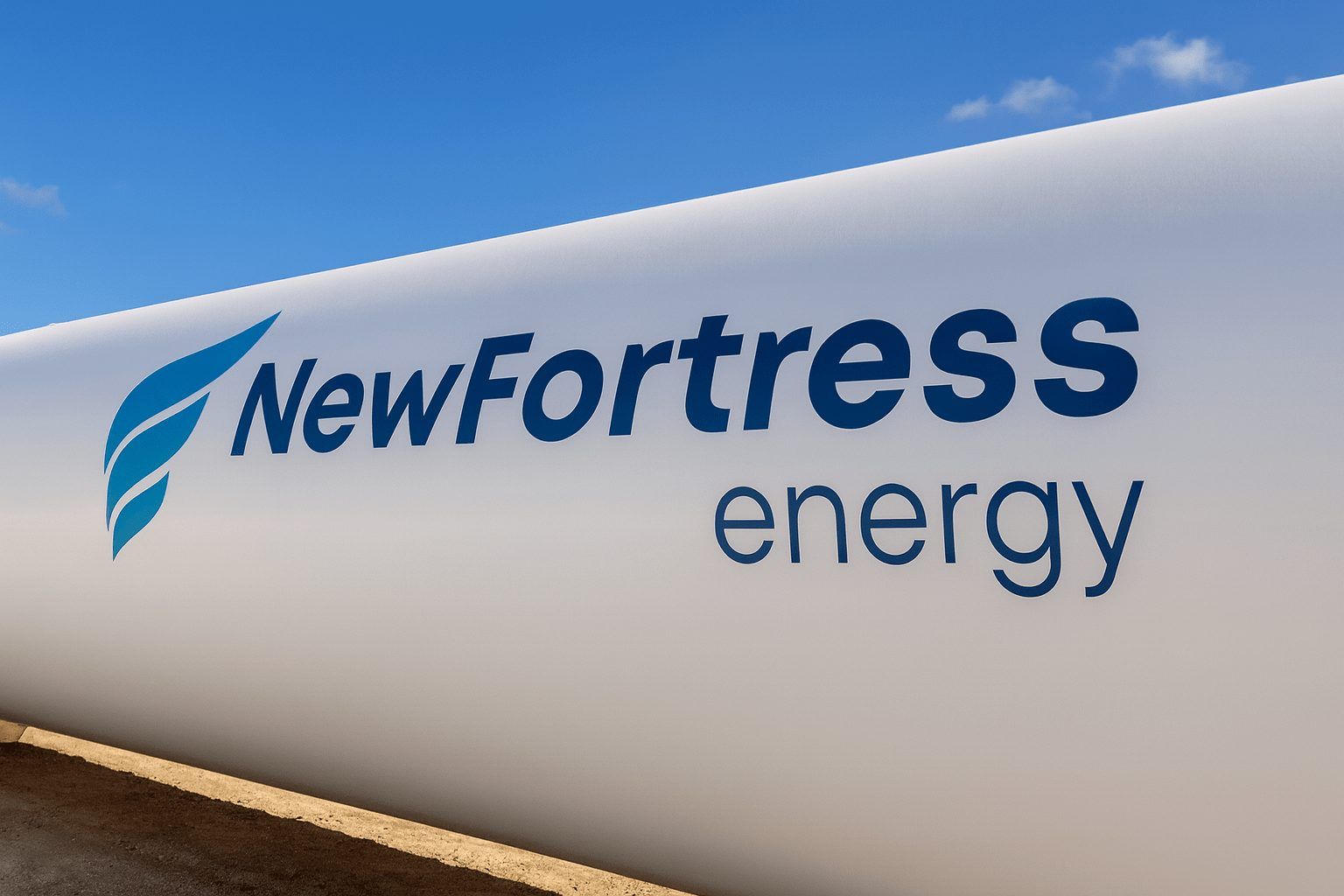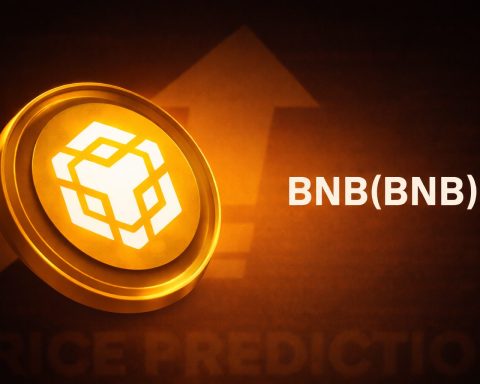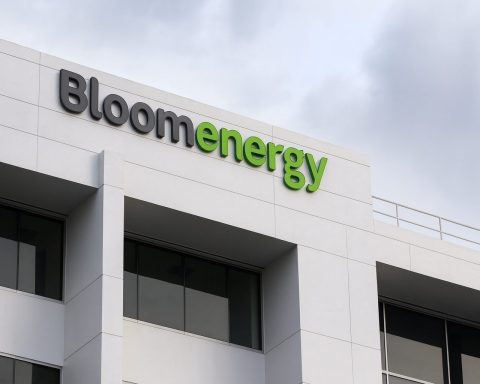New Fortress Energy Inc. (NASDAQ: NFE) is ending one of its most volatile weeks of 2025 under intense pressure, after a brutal selloff, a missed interest payment and a credit downgrade to Restricted Default.
Key Takeaways for NFE Stock Today
- Latest price: NFE last closed at $1.21 on Friday, November 21, 2025, down 17.1% on the day and roughly 92% lower year-to-date. [1]
- Hyper‑active trading: Around 37 million shares traded on Friday, close to or above the stock’s already‑elevated average daily volume (≈37.3 million), highlighting intense speculative interest. [2]
- Debt stress: NFE reported a Q3 2025 net loss of about $293 million, with quarterly interest expense tripling to about $210.6 million as high-cost debt weighs on results. [3]
- Default signal: Fitch Ratings downgraded NFE’s long‑term rating to “RD – Restricted Default” after the company missed a November 15 interest payment on 12% senior secured notes due 2029. [4]
- Temporary breathing room: A forbearance agreement and an amended credit facility push key deadlines into December 15, 2025 and March 31, 2026, but also underscore the risk of a broader restructuring that could hit existing shareholders. [5]
- Strategic hinge on Puerto Rico & Brazil: A $4 billion LNG contract with Puerto Rico—still subject to oversight board approval—and ramp‑up of the CELBA 2 power plant in Brazil are central to any long‑term recovery narrative. [6]
With markets closed this Sunday (November 23), these are the latest available figures and developments shaping NFE stock for the coming week.
NFE Stock Price Snapshot: November 23, 2025
As of the close on Friday, November 21, 2025, New Fortress Energy shares finished at $1.21, down from $1.46 the previous session, a one‑day decline of about 17.1%. [7]
Key recent trading stats:
- Friday intraday range: roughly $1.06 – $1.39 [8]
- Recent 52‑week range: about $0.98 – $16.66 [9]
- Average daily volume: around 37.3 million shares, meaning Friday’s ~37 million shares were near that elevated norm. [10]
- 1‑year performance: share price is down roughly 88–92% over the past 12 months, depending on the reference date. [11]
On current prices and share count, NFE’s market capitalization is about $340–350 million, versus an enterprise value around $9.5 billion, reflecting roughly $9+ billion of debt and other obligations on the balance sheet. [12]
In other words: the equity now represents a very thin slice of a heavily leveraged capital structure, which is exactly what debt markets and ratings agencies are focused on.
Q3 2025 Results: Deep Losses and Rising Interest Costs
New Fortress Energy finally released its third‑quarter 2025 results late last week, and they were grim:
- Q3 revenue: about $327 million, down sharply from roughly $568 million in the same quarter a year ago. [13]
- Q3 net income: swung from a small profit (~$11 million) last year to a net loss of about $293 million, or $1.07 per share. [14]
- Quarterly interest expense: surged to roughly $210.6 million, nearly three times the level a year earlier, as borrowing costs climbed and more debt piled up. [15]
The 10‑Q filing paints an even starker picture for the first nine months of 2025:
- Nine‑month net loss: about $1.05 billion, including a $582 million goodwill impairment and roughly $128 million in asset impairments, alongside project write‑downs (such as the Lakach deepwater project and a Pennsylvania development). [16]
- Revenue over nine months: fell to about $1.10 billion from $1.69 billion a year earlier, showing meaningful top‑line erosion. [17]
- Total principal debt: climbed to roughly $9.1 billion as of September 30, 2025, up from about $7.8 billion one year earlier. [18]
Management prepared the accounts on a “going concern” basis but warned there is “substantial doubt” about the company’s ability to continue operating without new financing or a significant restructuring. [19]
For equity investors, that explicit going‑concern warning is critical: it signals that both creditors and shareholders are now negotiating around downside scenarios, not growth stories.
Debt Crunch, Missed Interest, and Fitch’s “Restricted Default” Rating
The deterioration in NFE’s credit profile came to a head this month.
Missed interest payment and forbearance
- NFE missed an interest payment due November 15, 2025 on its 12% senior secured notes due 2029 (about $2.7 billion in principal). [20]
- The company subsequently signed a forbearance agreement with holders of those notes, effectively pushing the interest due date out to December 15, 2025 while talks continue. [21]
In parallel, NFE amended a letter of credit and reimbursement facility with Natixis, extending the maturity of that credit line to March 31, 2026 and granting temporary “covenant holidays” on key leverage and coverage tests for the September and December quarters. [22]
Those steps buy time—but they’re also a signal that normal financing conditions have broken down.
Fitch downgrade to “RD – Restricted Default”
On November 20, Fitch Ratings downgraded New Fortress Energy’s long‑term issuer default rating from “CCC” to “RD – Restricted Default”, explicitly citing the missed November 15 interest payment on the 12% notes. [23]
Fitch also:
- Cut several senior secured instruments to “C” with weak recovery expectations. [24]
- Pointed to “execution challenges” across projects and what it called an “untenable capital structure,” with leverage expected to stay extremely high in coming years. [25]
The agency estimated that NFE faces annual interest costs of around $900 million over the next three years, in the context of negative free cash flow and ongoing project spending—leaving little room to de‑lever organically. [26]
From an equity perspective, an “RD” rating often signals that some form of debt restructuring is likely, and restructurings frequently dilute or even wipe out existing common shareholders. No specific plan has been announced, but NFE has already hired advisors and has been exploring asset sales and strategic alternatives since last year. [27]
Puerto Rico LNG Contract: Potential Lifeline, Still Not Fully Secure
One of NFE’s biggest swing factors is its long‑term relationship with Puerto Rico’s power system.
In September 2025, Puerto Rico announced a $4 billion LNG supply contract with New Fortress Energy: [28]
- Term: 7 years, with an option for a 3‑year extension.
- Volumes: up to 75 trillion British thermal units (TBtu) per year, with a minimum “take‑or‑pay” commitment of 40 TBtu per year.
- Pricing: LNG priced at 115% of Henry Hub, plus $6.50–$7.95 per MMBtu.
- Source: A floating liquefaction unit at Altamira, Mexico, tied into NFE’s Fast LNG concept.
Shares jumped about 45% on the announcement back in September, showing how important the contract is to the equity story. [29]
However, the contract still requires approval from Puerto Rico’s Financial Oversight and Management Board (FOMB)—the same watchdog that has previously rejected NFE proposals it viewed as too onerous for ratepayers. [30]
An October analysis by the Institute for Energy Economics and Financial Analysis (IEEFA) highlighted several concerns around previous iterations of the deal: [31]
- Earlier versions would have locked Puerto Rico into purchasing more gas than its plants actually used, loading extra costs onto consumers via take‑or‑pay clauses.
- NFE’s LNG terminal and supply chain in San Juan have faced reliability issues, including missed deliveries and disruptions in 2021–2022 and mid‑2025.
- IEEFA noted that NFE itself has disclosed “substantial doubt” about its ability to continue as a going concern—raising questions about relying on the company as a long‑term supplier. [32]
In mid‑November, NFE said it had reached agreement on contract terms with Puerto Rico’s Third‑Party Procurement Office and Public‑Private Partnerships Authority for LNG supply, but again stressed that the deal is “under review” by the FOMB. [33]
For investors, that means:
- Approval could offer more stable, contracted revenue and improve NFE’s ability to refinance.
- Further pushback or rejection would reinforce the narrative that key growth projects are stuck in regulatory limbo.
Projects and Operations: CELBA 2, Fast LNG and Growth vs. Risk
Despite the financial stress, NFE is still pressing ahead with major infrastructure projects.
CELBA 2 in Brazil
According to recent company and research commentary: [34]
- CELBA 2 is a 624 MW gas‑fired power plant in northern Brazil.
- NFE has achieved “first fire,” meaning the turbines have been successfully ignited and hot commissioning has begun.
- Commercial operation is expected later in 2025, positioning Brazil as a major contributor to NFE’s future EBITDA.
Brazil is estimated to account for around 30% of NFE’s EBITDA in the mid‑2020s if projects ramp as planned, though that assumes smooth execution and ongoing access to fuel. [35]
Fast LNG and LNG shipping
NFE’s model revolves around Fast LNG—modular offshore liquefaction units—and an integrated fleet of ships, storage and regasification units: [36]
- One floating liquefaction unit off Altamira, Mexico is expected to supply LNG for the Puerto Rico contract and other markets. [37]
- The company operates terminals and regas facilities across Jamaica (before asset sales), Mexico and Brazil, plus LNG carriers and floating storage units. [38]
However, the Q2 and Q3 impairments, including write‑downs on Lakach and other developments, show that project selection and execution have not gone according to plan, and that some capital has already been destroyed. [39]
Fundamentals and Market Sentiment: Why the Stock Is So Volatile
Independent analysis of NFE’s fundamentals underscores just how stressed the story has become:
- Net debt to EBITDA: estimated around 46x, versus a market average nearer 1–2x—a level that leaves almost no margin for error. [40]
- Operating margin: slightly negative (~‑1.1%), far below typical energy infrastructure peers. [41]
- Free cash flow yield: deeply negative (around ‑56%), reflecting heavy capex and high interest costs. [42]
- Short interest: roughly 33% of the free float is sold short, indicating a large cohort of bearish traders betting on further downside or a dilutive restructuring. [43]
- Share statistics: about 284.6 million shares outstanding, with insiders owning roughly 37% and institutions about 46%. [44]
This combination—huge leverage, negative cash flow and very high short interest—helps explain why NFE’s daily moves have been so dramatic:
- On Thursday, November 20, the stock jumped about 26% in regular trading and over 20% after hours after the Natixis credit amendment and forbearance details emerged. [45]
- The very next day, it dropped more than 17%, erasing a chunk of those gains as investors digested the Fitch downgrade and Q3 numbers. [46]
For traders, this is the profile of a high‑beta, event‑driven small cap where news about debt talks, regulatory approvals or restructuring can move the price by double‑digit percentages in a single session.
What to Watch Next Week for NFE Stock
Going into the week of November 24, 2025, several signposts matter for anyone following NFE:
- December 15, 2025 — Forbearance expiry
- If NFE fails to cure the missed interest payment or agree a broader deal with noteholders by this date, creditors could move toward a more formal restructuring process. [47]
- Updates on Puerto Rico LNG contract
- Any decision by the FOMB to approve, modify or reject the $4 billion supply deal will be closely watched, given its potential to underpin long‑term cash flows. [48]
- Further disclosure on restructuring options
- Fitch and other observers expect NFE to pursue some form of capital restructuring, possibly including asset sales, debt exchanges or new equity—each with different implications for current shareholders. [49]
- Project milestones (CELBA 2 and Fast LNG)
- Progress toward full commercial operations at CELBA 2 and stability at the Altamira Fast LNG unit will feed into future earnings power and refinancing prospects. [50]
NFE: High‑Risk, Binary Setup Rather Than a Typical “Value” Stock
Putting it all together:
- Bullish thesis:
- NFE’s global LNG‑to‑power platform and projects in Brazil, Mexico and Puerto Rico could still generate substantial cash flow if they ramp successfully.
- A finalized Puerto Rico contract, successful project execution and a negotiated debt deal that leaves equity mostly intact could allow the stock to recover from current depressed levels. [51]
- Bearish thesis:
- Extremely high leverage, a formal “Restricted Default” rating, missed interest payments and going‑concern warnings point to a significant risk of dilution or even a wipe‑out of common shareholders in a deep restructuring. [52]
- Regulatory and reputational issues in Puerto Rico and prior project setbacks show that execution risk remains high. [53]
At current prices, NFE trades more like a speculative restructuring play than a traditional long‑term investment. Price swings are being driven less by quarterly EPS trends and more by legal, credit and regulatory milestones.
Bottom Line
For Sunday, November 23, 2025, the story on New Fortress Energy (NFE) is clear:
- The company remains financially distressed,
- The stock is extremely volatile, and
- The next few weeks—particularly the December 15 forbearance deadline and decisions around the Puerto Rico LNG contract—are likely to define whether equity holders face meaningful recovery potential or heavy dilution.
This article is for informational and news purposes only and does not constitute financial or investment advice. Anyone considering NFE should carefully review the company’s latest SEC filings, credit ratings reports and risk disclosures, and, if needed, speak with a qualified financial adviser.
References
1. www.aaii.com, 2. www.investing.com, 3. www.reuters.com, 4. www.fitchratings.com, 5. www.businesswire.com, 6. www.reuters.com, 7. www.aaii.com, 8. www.aaii.com, 9. www.investing.com, 10. www.investing.com, 11. www.investing.com, 12. stockanalysis.com, 13. www.marketscreener.com, 14. www.reuters.com, 15. www.reuters.com, 16. www.stocktitan.net, 17. www.stocktitan.net, 18. www.stocktitan.net, 19. www.reuters.com, 20. www.investing.com, 21. www.businesswire.com, 22. www.benzinga.com, 23. www.fitchratings.com, 24. www.tradingview.com, 25. www.investing.com, 26. www.investing.com, 27. www.reuters.com, 28. www.reuters.com, 29. www.reuters.com, 30. ieefa.org, 31. ieefa.org, 32. ieefa.org, 33. www.businesswire.com, 34. finimize.com, 35. www.investing.com, 36. finimize.com, 37. www.reuters.com, 38. www.aaii.com, 39. www.stocktitan.net, 40. finimize.com, 41. finimize.com, 42. finimize.com, 43. finimize.com, 44. stockanalysis.com, 45. www.benzinga.com, 46. www.aaii.com, 47. www.businesswire.com, 48. www.reuters.com, 49. www.investing.com, 50. finimize.com, 51. finimize.com, 52. www.tradingview.com, 53. ieefa.org







